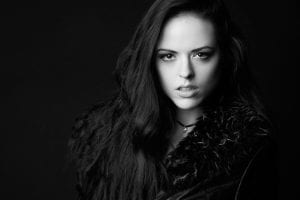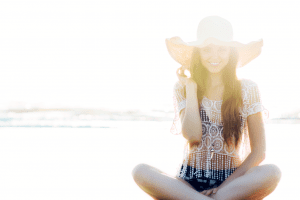Using Light to Achieve the Perfect Shot
You’ve heard the expression of seeing things in a “whole new light.” It’s true, lighting can completely change the way you see something. When posing, it can be your best friend or your worst enemy. It has the power to set the tone, set the mood, conceal, or reveal.
Lighting is crucial in the pursuit of the perfect shot.
Models, it’s imperative to understand light and shadow so you can give every photographer your best. Photographers, it’s crucial to know how to guide your talent to work with the available light. Today I’m going to teach you some of the best light concepts, tricks, and secrets that will help you in the place before the camera. Are you ready? Let’s get started…

Model: Ashley BeLoat
Photographer: Dan Mahar – http://www.danielvmahar.com/ – IG: @dan_mahar
The overall feel of a photo can be greatly influenced by the amount and quality of your light. If you have the luxury of shooting in a studio, you’ll have the ability to adjust things accordingly to your creative vision. If shooting outdoors, you’ll have to coordinate your vision with the sun, sky, and other outdoor light sources available to you. Is there a moody tone created by a gentle glow, plentiful shadows, and/or cooler tones? Or is there a more joyful and upbeat feel communicated with warmer, yellow hues and the casting of stronger beams? Is there a glorious backlight behind the model? Is the light shining in the direction of the camera towards the model? Know the tone you’re setting and tailor the posing and expressions accordingly.
For many portraits, the life of the photo is given in the face. Models, you must learn to sense how the light is hitting your face. If the light is hitting you from an angle, you may end up with shadows cast on one side from your nose and forehead. If the light is more overhead – as in midday – you will often have shadows cast downward over your eyes from your forehead. Of course all rules have their time and place to be broken, but here are some general things it is typically best to avoid…
- Darkness in the eyes: the eyes are the window to the soul. Draw all of your viewers in by lighting up the eyes. They’ll feel as if they’re being told a secret, receiving a message, or getting a true glimpse of who the person in the picture really is. If you want to go the extra mile, try to catch a glint of light precisely in your eye (without squinting) to add that extra sparkle. Just be careful! Don’t look directly into anything strong that may cause damage to your vision.
- Strong shadows cast from your own facial features: this can make them appear bigger than they really are in comparison to the rest of your face. It probably isn’t your goal to have an abnormally large nose or a very protruding forehead. You want your face to look as symmetrical as possible and let the expression be what catches everyone’s attention.
- Obstruction from hair: know that if you part your hair on the side, it may be blocking the light if it is shining from the direction that your hair is the thickest. To avoid this I will often flip my hair to the side opposite of the direction the light is coming from.
At the same time, it can really add a touch of mystery or to have shadows cast all about the model’s face. There are also some beautiful effects that can be created by casting patterns in the form of shadows as well. Make sure you communicate with the photographer about what the current creative vision. If they are up for experimentation, give it a try!

Model: Ashley BeLoat
Photographer: Derek O’Donnell – https://www.facebook.com/DO-Films-1066889343352160/ – IG: @derekod
It is also helpful to understand a general rule – what the light illuminates appears larger, and what the shadows touch appear smaller. This can help when you are positioning your body. Know how to tailor your go-to poses with the light that is available to you. Learn how your body and features look when lit from different angles. Your build and makeup is unique to you. What works for somebody else may not have the same effects for you. This is an aspect of modeling that comes with much practice, and as we all know…practice makes perfect!

Model: Ashley BeLoat
Designer: Inna Rudenko – www.innasdesigns.com – IG: @innasdesigns
Photographer: Ina Pandora – www.inapandora.com – IG: @inapandoraphotography
Hair and Makeup: Maryam Nash – https://www.facebook.com/makeupbymaryambahrami/ – IG: @makeupbymaryambahrami
One last thing I absolutely must discuss is backlighting. Backlighting can give the most beautiful halo effect. Not only will the model appear to glow, but the facial features will be softer as well. This can all work together to produce a very dreamy capture. Under certain conditions backlighting can also produce a silhouette result. If backlighting is in use, be sure you ask your photographer if your features are visible, or if you are only a silhouette. If the latter is his/her response, use your body to make whatever interesting shape you desire while making use of negative space to define your limbs and torso. If your features are still seen in the frame, make use of your expression to elevate the image to a new level.

Model: Ashley BeLoat
Photographer: Eric Kinney – www.erickinneyphotography.com – IG: @ekinneymedia
This concludes my little lesson on lighting. It is such an integral part of photography, and as models we can make or break a shoot with our knowledge of how to work with the setup. Our posing has to be tailored to a multitude of conditions each and every shoot. Each set brings a new array of challenges. I hope this article helps you walk onto yours with confidence, and show yourself in the very best light.
Until next time,
Ashley BeLoat
Website: https://www.facebook.com/Ashley.BeLoat.images/
Instagram: @ashleybeloat

Another great set of considerations you offer this entry. You are so right too, light or light shaping makes or breaks the shot.
Lighting is everything. It is so much better for the efficiency of the shoot when the model understands how to work with different types of light. I still have things to learn, but over the past three years I’ve already learned so much1
I love how insightful your article is on the impact of lighting on one’s body and features and vice versa. This is a great read that puts into consideration both the photographer and the model’s perspectives. Mastering the art of lighting shouldn’t apply to just photographers but to the models as well if you’re putting all that time, effort, and resources into each collaboration. If you’re a model whether amateur or experienced, make every moment count and treat each shot as if you were behind the camera!
The more a model learns about the science of photography, the quicker we can help you get the perfect shot. 🙂 Learning is crucial to helping us do a better job! That’s why I often pepper my makeup artists, designers, and photographers with questions on shoot day.